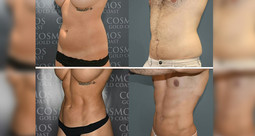Swelling is a normal part of recovery after any cosmetic or surgical procedure. While it can be uncomfortable, it’s an expected part of the healing process as your body repairs itself. That said, there are steps you can take to help manage it and support your recovery.
Why Swelling Occurs After Surgery
Swelling happens when fluid and white blood cells rush to the treatment area to start the repair process. This is a natural response as your body works to heal. Additionally, some procedures that use anaesthesia can cause fluid retention, adding to the initial swelling.
Swelling can vary depending on:
- The procedure performed
- How much tissue was treated
- Individual factors such as your body’s healing process
It’s also common to experience more swelling on one side than the other during recovery. This is completely normal and will even out over time.
How Long Does Swelling Last?
Swelling will be most noticeable immediately after your procedure and will peak within the first few days. You may start to see a reduction in swelling after about one week, but most of it will resolve within the first 6 weeks.
Here’s a rough guide:
- Week 1: Swelling and bruising are at their worst.
- Week 2: Approximately 75% of the swelling will have gone.
- Week 6: Around 90% of the swelling will resolve.
While the majority of the swelling will reduce during this time, it can take up to several months for the area to fully heal and settle.
Common Procedures Where Swelling Is Expected
Swelling can happen after most cosmetic procedures, but it’s particularly noticeable after:
Tips to Manage Swelling After Surgery
1. Prioritise Rest
Give your body time to heal by avoiding intense physical activity in the early stages of recovery. Follow your doctor’s advice for when to ease back into exercise.
2. Wear Compression Garments
Compression garments help control swelling and provide support to the treatment area. Make sure you wear them as instructed by your doctor for procedures like liposuction, BBL, or breast surgery.
3. Attend Lymphatic Massage Sessions
Lymphatic drainage massages can help reduce fluid build-up and improve circulation, which supports healing and swelling reduction.
4. Apply Cold Compresses
Cold packs can help reduce swelling and ease discomfort, especially during the first week. Be sure to wrap ice packs in a cloth to protect your skin.
5. Stay Hydrated
Drinking plenty of water helps flush out toxins and keeps your body functioning at its best during recovery.
6. Maintain a Nutritious Diet
Focus on foods rich in vitamins, minerals, and anti-inflammatory properties. These can support healing and reduce swelling. Examples include leafy greens, salmon, berries, and citrus fruits.
7. Avoid Smoking and Alcohol
Smoking can restrict blood flow, slowing down the healing process. Alcohol can also contribute to inflammation and fluid retention.
8. Avoid Excess Salt
High-sodium foods can cause your body to retain fluid, which can worsen swelling. Stick to whole foods and limit processed or fast foods.
What to Avoid to Reduce Swelling
- Smoking and smoke exposure
- Blood-thinning medications (consult your doctor before taking any new medications)
- Too much caffeine
- Salty or processed foods
Recovery Takes Time
Swelling is a natural part of the healing process, but with proper care, you can minimise its impact and support your recovery. Always follow your doctor’s post-operative instructions closely and reach out if you have concerns about your healing.
For more recovery tips and detailed aftercare, explore our Post-Procedure Information page or contact our team at Cosmos Clinic to discuss your treatment plan.






